| ID |
Date |
Author |
Subject |
|
663
|
Fri Mar 2 18:08:55 2018 |
Steven Block | ROI | Hello,
I have a question about how ROI works. From what I have read, it will only save data that ocurs some time [ta] dictated by the user after an event is triggered as well as a small time [tb] before the event. The technical manual seems to indicated that the deadtime assciated with operating in ROI mode can be reduced by the following factor:
 . .
Where N is the number of points in the time window (ex. 2048 or 1024). Is it ok to describe this as:

Where N' is the number of samples in the ROI and N is the same as before.
For example, if I were running at 5Gsps (200ps between samples), only recording 1024 samples per event and I had an signal that lasted 2ns, that means the signal would last 10 samples. If I set the ROI to only save 20 samples around this signal, would my Deadtime go to:
 ? (The second portion of this equation comes from a response I recieved earlier, but I just want to make sure I understand this concept properly) ? (The second portion of this equation comes from a response I recieved earlier, but I just want to make sure I understand this concept properly)
I recognize that the caveat is that this would work only if the signal was detected during acquistion, which leads to my next question. If no signals were detected in the 1024*200ps time frame in ROI mode, would the DRS4 go dead for 32us (using the factor = 1 from above equation), or would it dump the earliest events in the buffer for the more recent ones until it detects a signal?
Finally, I assume this functionality can only be utilized with custom electornics with the DRS4, not the evaulation/demo board, please let me know if this is the case.
Best,
Steven |
|
662
|
Tue Feb 27 18:12:32 2018 |
Stefan Ritt | DRS4 Dead times | For applications which are critical on the dead time, one typically uses one ADC per DRS4 channel, and thus the dead time stays at 32us. If you multiplex two DRS4 channels into one ADC channel, then it goes to 32us.
Stefan
| Steven Block wrote: |
|
That is extremely helpful! Many thanks. One more question; If I were to take inputs from 2 channels at once, would that scale the dead time to 64us using your example?
Steven
| Stefan Ritt wrote: |
|
XML is very slow to write, and you are probably limited by that. Switch to binary mode, which is much faster. You will see in the end a maximum rate of ~500 Hz, and thus a dead time of 2ms, independent of the sampling speed. Note that you have only an evaluation board, which is optimized for ease of use. If you develop your own electronics, and do optimized readout, you can bring the deadtime down to 30ns x number of samples + 2us, or 32us if you read 1024 values from one channel.
Stefan
| Steven Block wrote: |
|
Hello All,
I am currently trying to figure out how to properly characterize the dead time of the DRS4 board. My most recent experiment to try and answer this question involved using an external trigger that can range from 1Hz to 2MHz. I fed this trigger into the DRS4 and collected 1000 samples with no input to any channels. I repeated this across the range of my external trigger by a factor of ten [10Hz, 100Hz, 1kHz...etc]. After I had saved these runs in XML format, I looked at the difference between timestamps on the events. Attached are my findings. Can someone offer an explanation for the periodic peaks? I am new to the DRS4 and don't really understand how it works. My guess is that there is a buffer that has to be emptied every so often, but if so, the buffer emptying time varies with the frequency of the trigger. I would ideally like to be able to know the relation of the dead time to a particular setting I change on the DRS4 such as locking the sampling speed or changing external trigger frequency.
Best,
Steven
|
|
|
|
|
661
|
Tue Feb 27 18:04:18 2018 |
Steven Block | DRS4 Dead times | That is extremely helpful! Many thanks. One more question; If I were to take inputs from 2 channels at once, would that scale the dead time to 64us using your example?
Steven
| Stefan Ritt wrote: |
|
XML is very slow to write, and you are probably limited by that. Switch to binary mode, which is much faster. You will see in the end a maximum rate of ~500 Hz, and thus a dead time of 2ms, independent of the sampling speed. Note that you have only an evaluation board, which is optimized for ease of use. If you develop your own electronics, and do optimized readout, you can bring the deadtime down to 30ns x number of samples + 2us, or 32us if you read 1024 values from one channel.
Stefan
| Steven Block wrote: |
|
Hello All,
I am currently trying to figure out how to properly characterize the dead time of the DRS4 board. My most recent experiment to try and answer this question involved using an external trigger that can range from 1Hz to 2MHz. I fed this trigger into the DRS4 and collected 1000 samples with no input to any channels. I repeated this across the range of my external trigger by a factor of ten [10Hz, 100Hz, 1kHz...etc]. After I had saved these runs in XML format, I looked at the difference between timestamps on the events. Attached are my findings. Can someone offer an explanation for the periodic peaks? I am new to the DRS4 and don't really understand how it works. My guess is that there is a buffer that has to be emptied every so often, but if so, the buffer emptying time varies with the frequency of the trigger. I would ideally like to be able to know the relation of the dead time to a particular setting I change on the DRS4 such as locking the sampling speed or changing external trigger frequency.
Best,
Steven
|
|
|
|
660
|
Tue Feb 27 17:04:12 2018 |
Stefan Ritt | DRS4 Dead times | XML is very slow to write, and you are probably limited by that. Switch to binary mode, which is much faster. You will see in the end a maximum rate of ~500 Hz, and thus a dead time of 2ms, independent of the sampling speed. Note that you have only an evaluation board, which is optimized for ease of use. If you develop your own electronics, and do optimized readout, you can bring the deadtime down to 30ns x number of samples + 2us, or 32us if you read 1024 values from one channel.
Stefan
| Steven Block wrote: |
|
Hello All,
I am currently trying to figure out how to properly characterize the dead time of the DRS4 board. My most recent experiment to try and answer this question involved using an external trigger that can range from 1Hz to 2MHz. I fed this trigger into the DRS4 and collected 1000 samples with no input to any channels. I repeated this across the range of my external trigger by a factor of ten [10Hz, 100Hz, 1kHz...etc]. After I had saved these runs in XML format, I looked at the difference between timestamps on the events. Attached are my findings. Can someone offer an explanation for the periodic peaks? I am new to the DRS4 and don't really understand how it works. My guess is that there is a buffer that has to be emptied every so often, but if so, the buffer emptying time varies with the frequency of the trigger. I would ideally like to be able to know the relation of the dead time to a particular setting I change on the DRS4 such as locking the sampling speed or changing external trigger frequency.
Best,
Steven
|
|
|
659
|
Tue Feb 27 16:34:26 2018 |
Steven Block | DRS4 Dead times | Hello All,
I am currently trying to figure out how to properly characterize the dead time of the DRS4 board. My most recent experiment to try and answer this question involved using an external trigger that can range from 1Hz to 2MHz. I fed this trigger into the DRS4 and collected 1000 samples with no input to any channels. I repeated this across the range of my external trigger by a factor of ten [10Hz, 100Hz, 1kHz...etc]. After I had saved these runs in XML format, I looked at the difference between timestamps on the events. Attached are my findings. Can someone offer an explanation for the periodic peaks? I am new to the DRS4 and don't really understand how it works. My guess is that there is a buffer that has to be emptied every so often, but if so, the buffer emptying time varies with the frequency of the trigger. I would ideally like to be able to know the relation of the dead time to a particular setting I change on the DRS4 such as locking the sampling speed or changing external trigger frequency.
Best,
Steven |
| Attachment 1: 1kHz.png
|
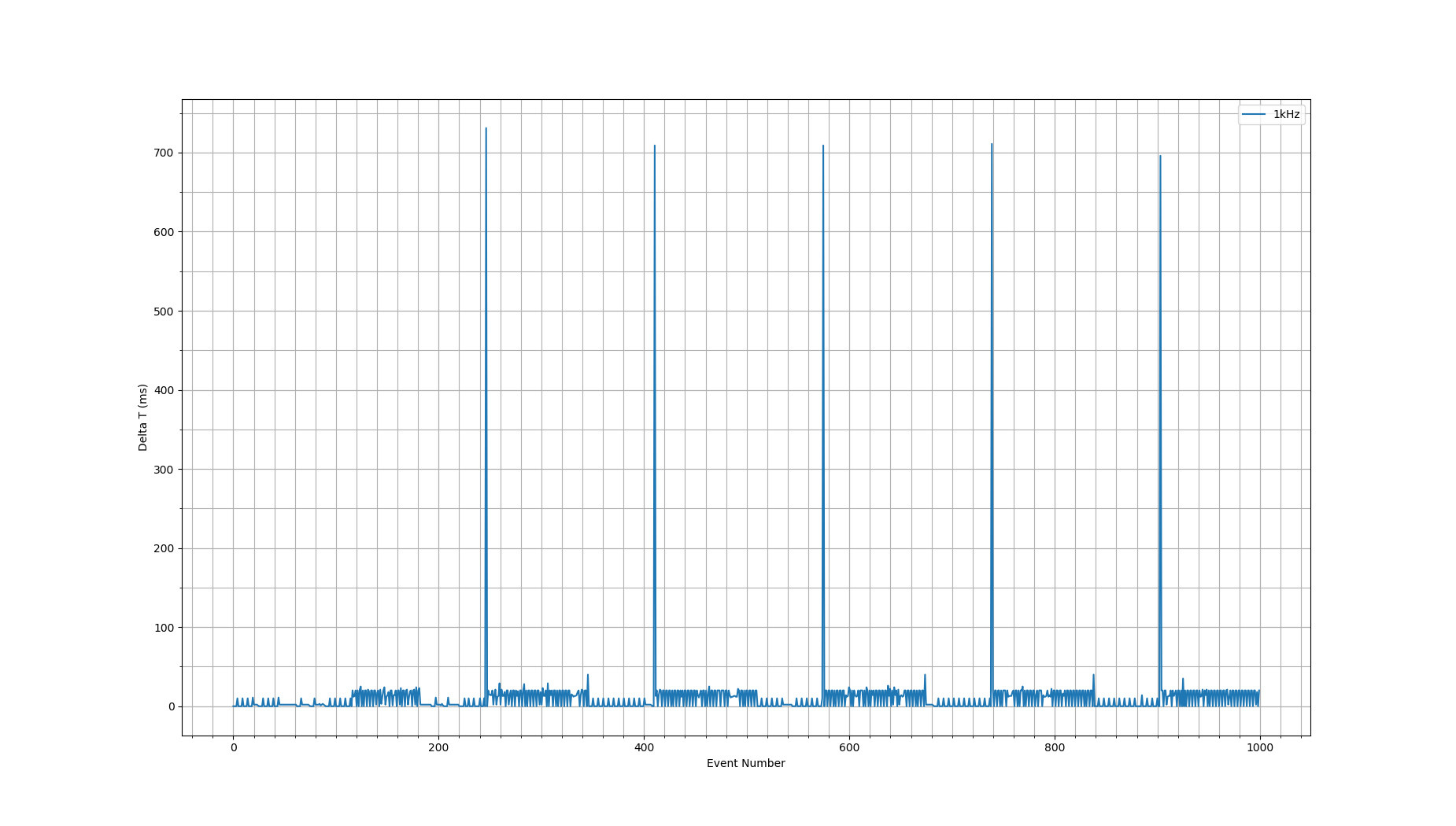
|
| Attachment 2: 1MHz.png
|
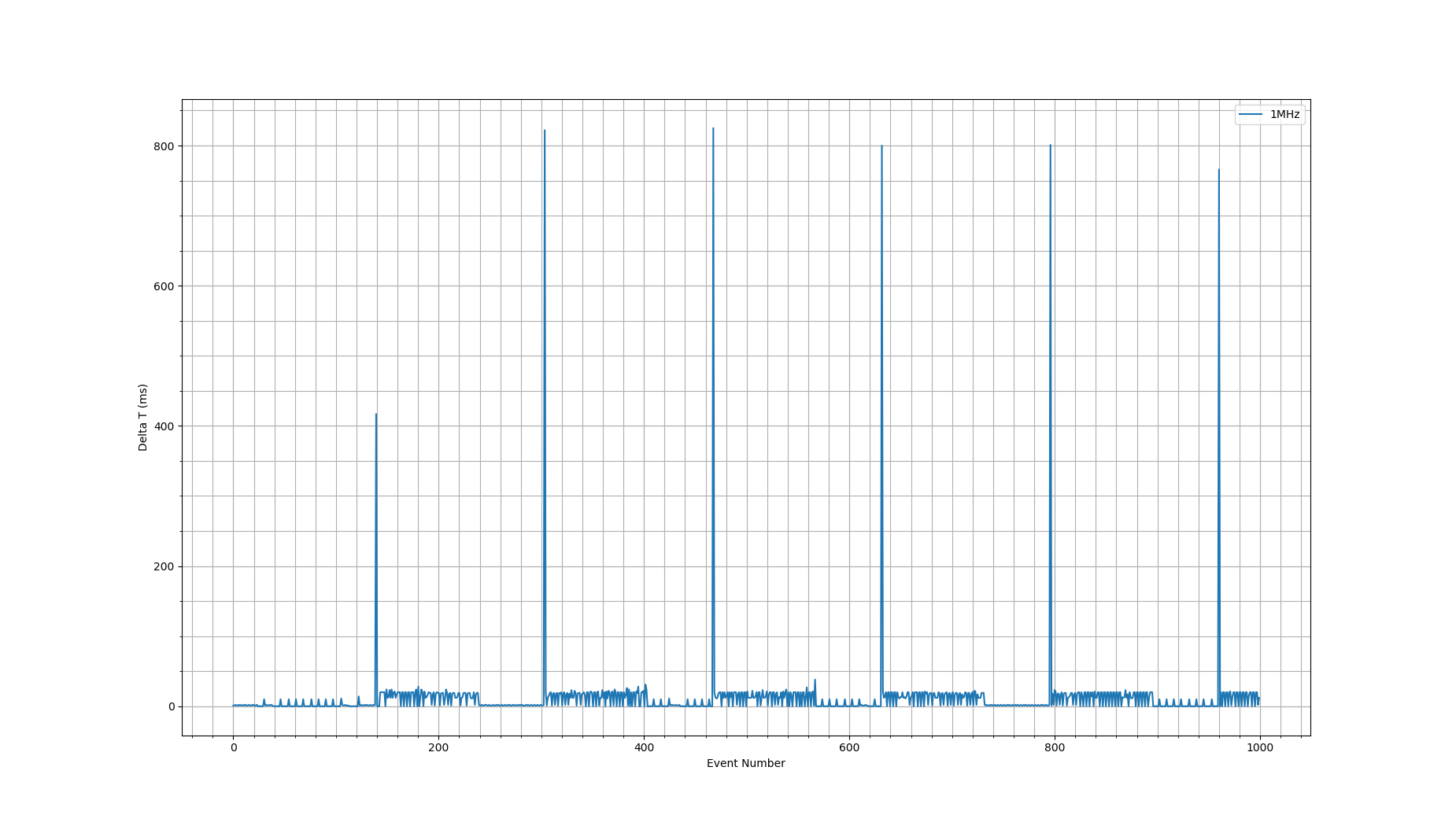
|
| Attachment 3: 10Hz.png
|
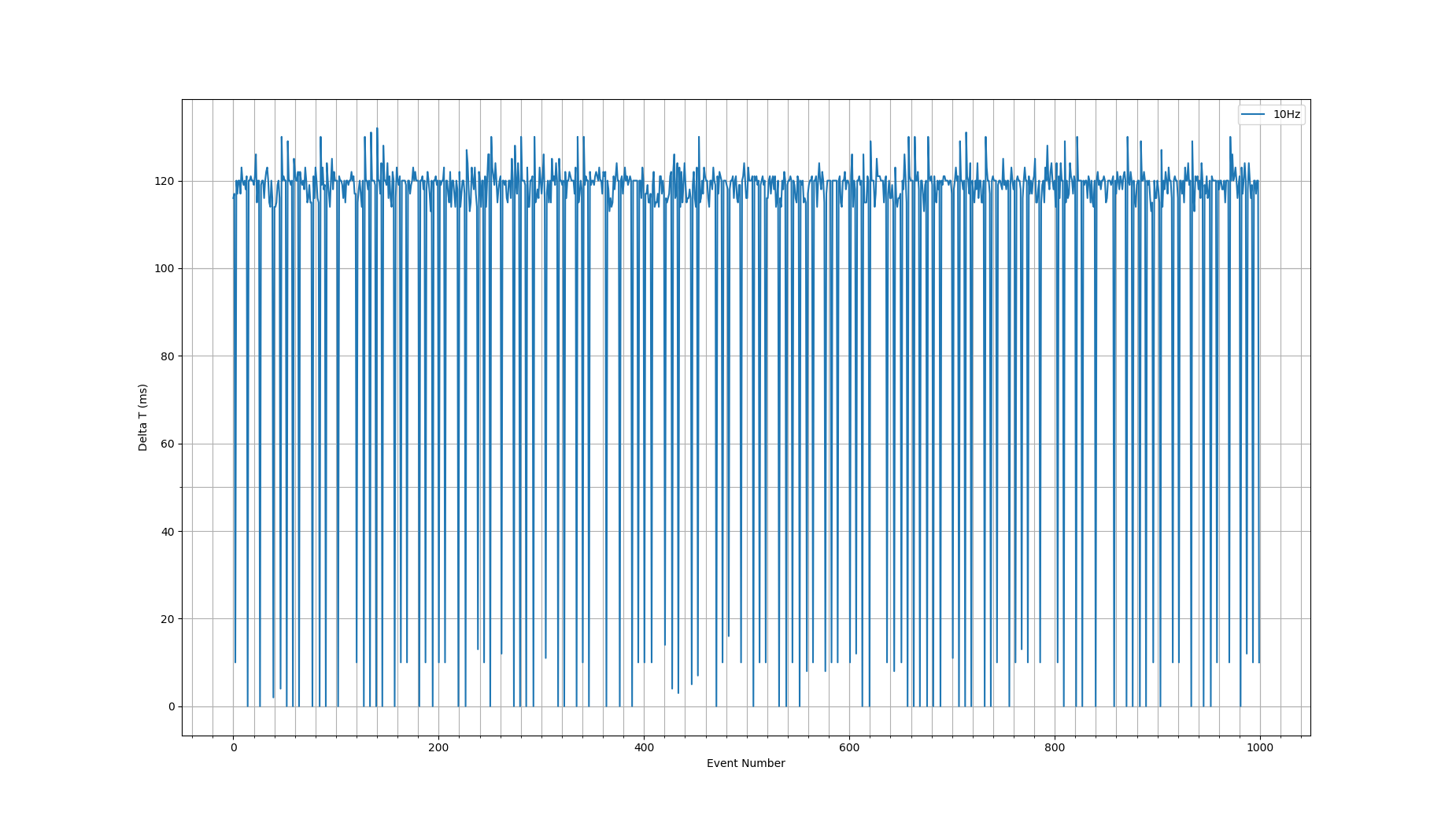
|
| Attachment 4: 10kHz.png
|
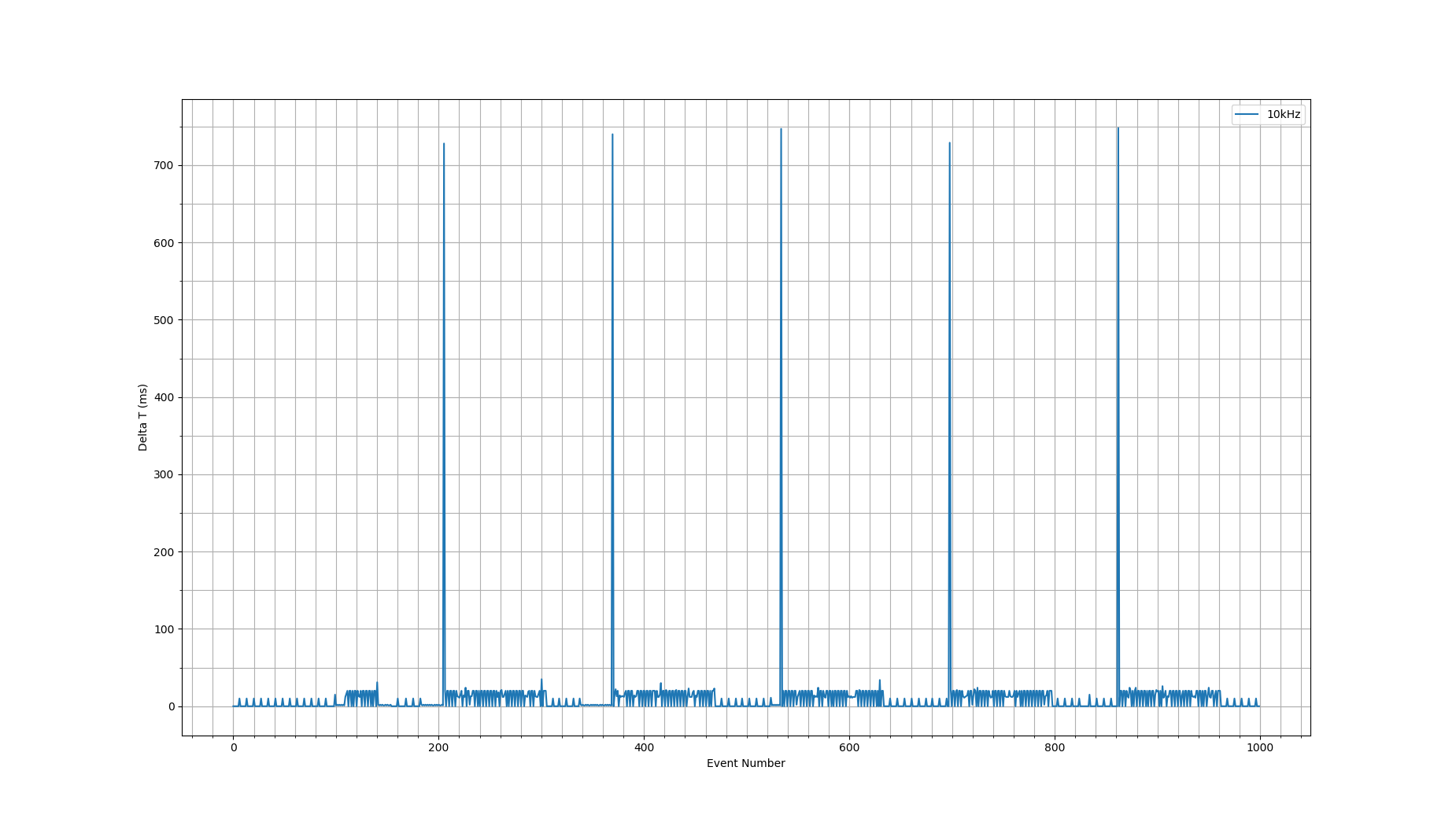
|
| Attachment 5: 100Hz.png
|
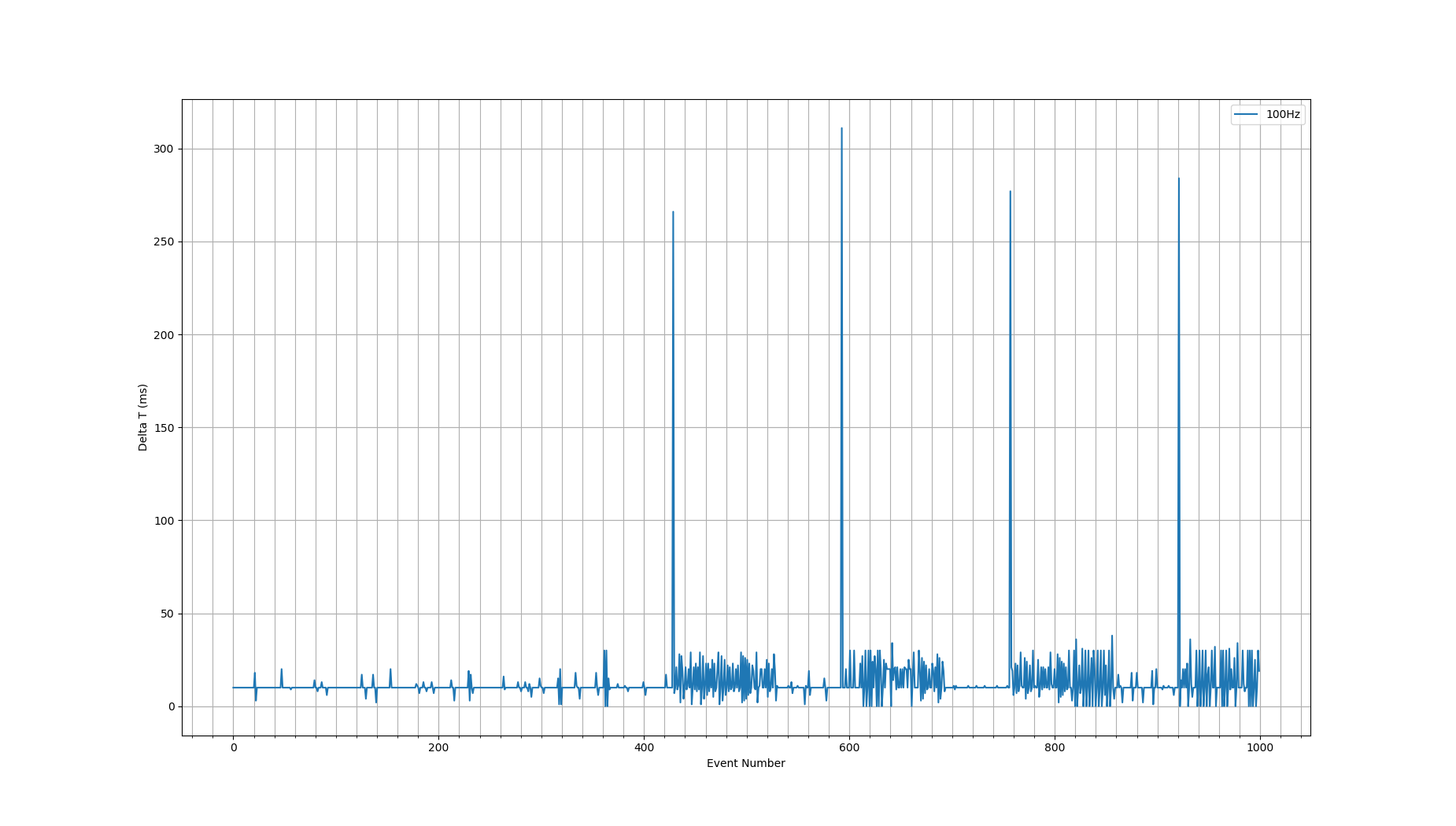
|
| Attachment 6: 100kHz.png
|
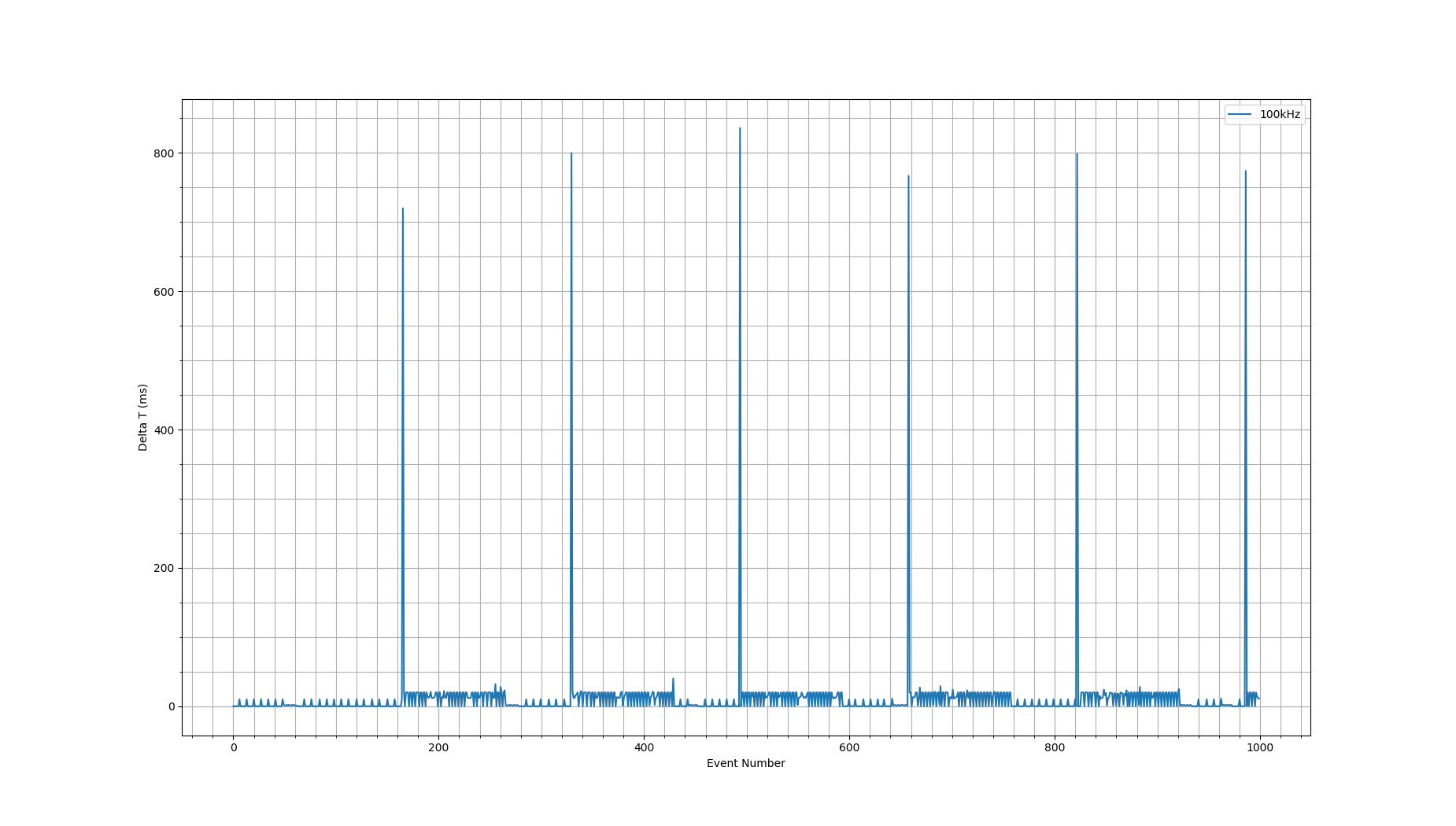
|
|
658
|
Tue Feb 27 13:29:47 2018 |
Stefan Ritt | WIndows Connection problem with drs507 SOLVED | Dear Steven, many thanks for this information, this is very useful. I know of people having problems on Windows 10, maybe this will also help them.
Stefan
| Steven Block wrote: |
|
Hello All,
I too have been struggling with trying to get the drs4 (507) to work on my windows machine and I found it to be a problem with the libusb library. My solution is as follows and has worked on multiple PC's. I ran this solution after I first plugged in the drs4 and installed 507.
Go to http://zadig.akeo.ie/ and install the corresponding software.
After that, you will need to plug in the DRS4 to your computer. From there go to ‘Options’, and select ‘List all Devices’.
Finally, choose the DRS4 evaluation board from the list and press install driver and let it run. You should be fine after that.
Best,
Steven
|
|
|
657
|
Tue Feb 27 13:17:00 2018 |
Steven Block | WIndows Connection problem with drs507 SOLVED | Hello All,
I too have been struggling with trying to get the drs4 (507) to work on my windows machine and I found it to be a problem with the libusb library. My solution is as follows and has worked on multiple PC's. I ran this solution after I first plugged in the drs4 and installed 507.
Go to http://zadig.akeo.ie/ and install the corresponding software.
After that, you will need to plug in the DRS4 to your computer. From there go to ‘Options’, and select ‘List all Devices’.
Finally, choose the DRS4 evaluation board from the list and press install driver and let it run. You should be fine after that.
Best,
Steven |
|
656
|
Thu Jan 25 08:07:32 2018 |
chen wenjun | problem with the drscl(drs507) | I have tried about 4 computers,only one worked fine.I truly want to know how others get this fixed,can you get in touch with them?
| Stefan Ritt wrote: |
|
This problem has been reported by several people, like elog:551
So far I could not solve it. On the computers at our lab it works find so I cannot reproduce and fix the problem. One suspicion I have is that the underlying libusb library needs to be updated. You can try to install the newest version from their website at http://libusb.info/, but I haven't tried it myself.
Stefan
| chen wenjun wrote: |
|
Hi! Stefan:
when I change a new computer(win7,64bit),I meet a problem that the drscl app cannot found the board! It shows"USB successfully scanned,but no boards found",but the drsosc runs well . when I connect to other win7*64bits computer,only one of them runs property! Is there any driver else I need to install?
Thank you!
Chen
|
|
|
|
655
|
Thu Jan 25 08:00:16 2018 |
Stefan Ritt | problem with the drscl(drs507) | This problem has been reported by several people, like elog:551
So far I could not solve it. On the computers at our lab it works find so I cannot reproduce and fix the problem. One suspicion I have is that the underlying libusb library needs to be updated. You can try to install the newest version from their website at http://libusb.info/, but I haven't tried it myself.
Stefan
| chen wenjun wrote: |
|
Hi! Stefan:
when I change a new computer(win7,64bit),I meet a problem that the drscl app cannot found the board! It shows"USB successfully scanned,but no boards found",but the drsosc runs well . when I connect to other win7*64bits computer,only one of them runs property! Is there any driver else I need to install?
Thank you!
Chen
|
|
|
654
|
Thu Jan 25 06:10:52 2018 |
chen wenjun | drscl doesn't find eval board but drsosc does (Windows 7) | Hi! Jim:
It seems that I meet the same question with you ,and I am confused ,have you find out the reason about this problem?Or can you tell me how you deal with it?
Thank you very much!
chen
| Jim Freeman wrote: |
|
I cannot find the EVAL board using drscl version 5.06 while the drsosc works fine. I tried 2 different eval boards and 2 different computers and the same effect. I looked under device manager at the libusb and the drs4 was there, and checked the driver which was found to be up to date.
|
|
|
653
|
Thu Jan 25 05:24:05 2018 |
chen wenjun | problem with the drscl(drs507) | Hi! Stefan:
when I change a new computer(win7,64bit),I meet a problem that the drscl app cannot found the board! It shows"USB successfully scanned,but no boards found",but the drsosc runs well . when I connect to other win7*64bits computer,only one of them runs property! Is there any driver else I need to install?
Thank you!
Chen |
|
652
|
Wed Jan 17 10:09:09 2018 |
Stefan Ritt | The input signals recorded are different with the signal showed in oscilloscope | First thing is to do another voltage calibration. Disconnect input, "Config", "Execute Voltage Calibration". If this does not fix the problem, the board is probably broken. This can happen if you send very high input singals to the board (like >10V) and exceed the maximul allowed limit from the datasheet. In that case the board needs to be repaired. Please contact me directly (via email) so that we can make you a quote.
Best regards,
Stefan
| Tran Cong Thien wrote: |
|
Dear Stefan,
I am using an DRS4 board to record the signals from an plastic scintillator detector. It was working really good, yet a few day ago the signals became "not right". When I checked the signal using an oscilloscope it show the normal signals previously recorded. The signal amplitude are clearly reduced (from 0.3 in oscilloscope to lower than 0.1 in DRS4). Can you show me how to show this problem?
Thank you very much!
Best Regards,
Thien
|
|
|
651
|
Wed Jan 17 09:51:16 2018 |
Tran Cong Thien | The input signals recorded are different with the signal showed in oscilloscope | Dear Stefan,
I am using an DRS4 board to record the signals from an plastic scintillator detector. It was working really good, yet a few day ago the signals became "not right". When I checked the signal using an oscilloscope it show the normal signals previously recorded. The signal amplitude are clearly reduced (from 0.3 in oscilloscope to lower than 0.1 in DRS4). Can you show me how to show this problem?
Thank you very much!
Best Regards,
Thien |
|
650
|
Wed Dec 20 22:14:35 2017 |
Stefan Ritt | cascading -- DRS4 Osci.cpp & DRS.cpp | https://bitbucket.org/ritt/drs4eb
|
|
649
|
Wed Dec 20 16:30:45 2017 |
Yoni Sher | cascading -- DRS4 Osci.cpp & DRS.cpp | Hi,
The board is modified (and checks out with the DRSScope program). Could you please point me to the drs_exam_2048.cpp file? I can't seem to fine the most up-to-date git repository....
Thanks,
Yoni
| Stefan Ritt wrote: |
|
First you need a board which is modified in hardware to support channel cascading. Basically there are internal resistors which connect each input connector to two channels. You have to specify this when you order the board. Then you can use the new drs_exam_2048.cpp file contains in the git repository which correctly configures and reads out the board in two-channel cascading mode. Putting all 8 channels together is not supported by the evaluation boards.
Stefan
| Yoni Sher wrote: |
|
Hi,
I'm trying to do the same thing (get 1 channel with 8192 bins), but I'm having some trouble with it. When I call SetChannelConfig(0, 8, 1) as suggeted, I get output that looks like noise on all readouts. Could you please explain what is supposed to happen in this case?
I will happily write the code to combine the channels correctly (and debug it) if I can understand what needs to be done.
(I should mention that my primary concern is a MATLAB interface which I have already written and don't mind sharing when it's complete).
Yoni Sher
| Stefan Ritt wrote: |
|
| Jill Russek wrote: |
|
| Stefan Ritt wrote: |
|
| Jill Russek wrote: |
|
Stefan, thanks for your help so far. If I go with your plan A of just modifying drs_exam.cpp, is there a quick way to get it to save the data from the wave, like how osci.cpp spits out an xml file? (Ignoring the cascading aspect for now)
Thanks again :)
/Jill
|
Well, you have to learn C programming, I won't do it for you. drs_exam.cpp contains already code to write to the ASCII file data.txt, so you just can use that or modify it to your needs.
/Stefan
|
Ha! So then the answer is no, there isn't a ready made function/method to pull out the timing and voltage, like how it was done in osci.cpp. That's all I wanted to know. (Not whether you would write it for me! Only trying to save time!) Thanks!
/Jill
|
You misunderstood. The answer is yes. drs_exam.cpp contains already code to write to an ASCII file. If you actually look into the file, you see:
f = fopen("data.txt", "w");
...
b->GetTime(0, b->GetTriggerCell(0), time_array);
...
b->GetWave(0, 0, wave_array[0]);
...
fprintf(f, "%5.2f %6.2f\n", time_array[i], wave_array[0][i]);
which actually pulls out the timing and voltage and writes it to the file.
|
|
|
|
|
648
|
Wed Dec 20 16:21:42 2017 |
Stefan Ritt | cascading -- DRS4 Osci.cpp & DRS.cpp | First you need a board which is modified in hardware to support channel cascading. Basically there are internal resistors which connect each input connector to two channels. You have to specify this when you order the board. Then you can use the new drs_exam_2048.cpp file contains in the git repository which correctly configures and reads out the board in two-channel cascading mode. Putting all 8 channels together is not supported by the evaluation boards.
Stefan
| Yoni Sher wrote: |
|
Hi,
I'm trying to do the same thing (get 1 channel with 8192 bins), but I'm having some trouble with it. When I call SetChannelConfig(0, 8, 1) as suggeted, I get output that looks like noise on all readouts. Could you please explain what is supposed to happen in this case?
I will happily write the code to combine the channels correctly (and debug it) if I can understand what needs to be done.
(I should mention that my primary concern is a MATLAB interface which I have already written and don't mind sharing when it's complete).
Yoni Sher
| Stefan Ritt wrote: |
|
| Jill Russek wrote: |
|
| Stefan Ritt wrote: |
|
| Jill Russek wrote: |
|
Stefan, thanks for your help so far. If I go with your plan A of just modifying drs_exam.cpp, is there a quick way to get it to save the data from the wave, like how osci.cpp spits out an xml file? (Ignoring the cascading aspect for now)
Thanks again :)
/Jill
|
Well, you have to learn C programming, I won't do it for you. drs_exam.cpp contains already code to write to the ASCII file data.txt, so you just can use that or modify it to your needs.
/Stefan
|
Ha! So then the answer is no, there isn't a ready made function/method to pull out the timing and voltage, like how it was done in osci.cpp. That's all I wanted to know. (Not whether you would write it for me! Only trying to save time!) Thanks!
/Jill
|
You misunderstood. The answer is yes. drs_exam.cpp contains already code to write to an ASCII file. If you actually look into the file, you see:
f = fopen("data.txt", "w");
...
b->GetTime(0, b->GetTriggerCell(0), time_array);
...
b->GetWave(0, 0, wave_array[0]);
...
fprintf(f, "%5.2f %6.2f\n", time_array[i], wave_array[0][i]);
which actually pulls out the timing and voltage and writes it to the file.
|
|
|
|
647
|
Wed Dec 20 15:30:38 2017 |
Yoni Sher | cascading -- DRS4 Osci.cpp & DRS.cpp | Hi,
I'm trying to do the same thing (get 1 channel with 8192 bins), but I'm having some trouble with it. When I call SetChannelConfig(0, 8, 1) as suggeted, I get output that looks like noise on all readouts. Could you please explain what is supposed to happen in this case?
I will happily write the code to combine the channels correctly (and debug it) if I can understand what needs to be done.
(I should mention that my primary concern is a MATLAB interface which I have already written and don't mind sharing when it's complete).
Yoni Sher
| Stefan Ritt wrote: |
|
| Jill Russek wrote: |
|
| Stefan Ritt wrote: |
|
| Jill Russek wrote: |
|
Stefan, thanks for your help so far. If I go with your plan A of just modifying drs_exam.cpp, is there a quick way to get it to save the data from the wave, like how osci.cpp spits out an xml file? (Ignoring the cascading aspect for now)
Thanks again :)
/Jill
|
Well, you have to learn C programming, I won't do it for you. drs_exam.cpp contains already code to write to the ASCII file data.txt, so you just can use that or modify it to your needs.
/Stefan
|
Ha! So then the answer is no, there isn't a ready made function/method to pull out the timing and voltage, like how it was done in osci.cpp. That's all I wanted to know. (Not whether you would write it for me! Only trying to save time!) Thanks!
/Jill
|
You misunderstood. The answer is yes. drs_exam.cpp contains already code to write to an ASCII file. If you actually look into the file, you see:
f = fopen("data.txt", "w");
...
b->GetTime(0, b->GetTriggerCell(0), time_array);
...
b->GetWave(0, 0, wave_array[0]);
...
fprintf(f, "%5.2f %6.2f\n", time_array[i], wave_array[0][i]);
which actually pulls out the timing and voltage and writes it to the file.
|
|
|
646
|
Tue Dec 12 13:58:06 2017 |
Stefan Ritt | External trigger using Raspberry Pi | Indeed the code does not work for the current evaluation board, it has been written for a previous version and never been updated. Please use following code to enable the external trigger
/* use following lines to enable the external trigger */
if (b->GetBoardType() >= 8) { // Evaluaiton Board V4&5
b->EnableTrigger(1, 0); // enable hardware trigger
b->SetTriggerConfig(1<<4); // set external trigger as source
} else { // Evaluation Board V3
b->EnableTrigger(1, 0); // lemo on, analog trigger offf
}
Please also make sure that the signal on the external trigger input is strong enough. You need at least 2.5V at 50 Ohms, and not every driver is capable of driving 50 Ohms.
Stefan
| Diego Yankelevich wrote: |
|
Dear Steffan:
We have been able to use the DRS4 using a Raspberry Pi but we have not been able to use the external trigger. What we are doing is basically comment out the code shown below (downloaded from PSI) to use the hardware trigger and uncomment the code to use the external trigger. We have not been able to get external trigger to work. Could you see what could be wrong?
Thanks
Diego
/* use following line to turn on the internal 100 MHz clock connected to all channels */
//b->EnableTcal(1);
/* use following lines to enable hardware trigger on CH1 at 50 mV positive edge */
/*
if (b->GetBoardType() >= 8) { // Evaluaiton Board V4&5
b->EnableTrigger(1, 0); // enable hardware trigger
b->SetTriggerSource(1<<0); // set CH1 as source
} else if (b->GetBoardType() == 7) { // Evaluation Board V3
b->EnableTrigger(0, 1); // lemo off, analog trigger on
b->SetTriggerSource(0); // use CH1 as source
}
b->SetTriggerLevel(0.05); // 0.05 V
b->SetTriggerPolarity(false); // positive edge
*/
/* use following lines to set individual trigger elvels */
//b->SetIndividualTriggerLevel(1, 0.1);
//b->SetIndividualTriggerLevel(2, 0.2);
//b->SetIndividualTriggerLevel(3, 0.3);
//b->SetIndividualTriggerLevel(4, 0.4);
//b->SetTriggerSource(15);
b->SetTriggerDelayNs(0); // zero ns trigger delay
/* use following lines to enable the external trigger */
if (b->GetBoardType() == 8) { // Evaluaiton Board V4
b->EnableTrigger(1, 0); // enable hardware trigger
b->SetTriggerSource(1<<4); // set external trigger as source
} else { // Evaluation Board V3
b->EnableTrigger(1, 0); // lemo on, analog trigger off
}
|
|
|
645
|
Tue Dec 12 00:25:50 2017 |
Diego Yankelevich | External trigger using Raspberry Pi | Dear Steffan:
We have been able to use the DRS4 using a Raspberry Pi but we have not been able to use the external trigger. What we are doing is basically comment out the code shown below (downloaded from PSI) to use the hardware trigger and uncomment the code to use the external trigger. We have not been able to get external trigger to work. Could you see what could be wrong?
Thanks
Diego
/* use following line to turn on the internal 100 MHz clock connected to all channels */
//b->EnableTcal(1);
/* use following lines to enable hardware trigger on CH1 at 50 mV positive edge */
/*
if (b->GetBoardType() >= 8) { // Evaluaiton Board V4&5
b->EnableTrigger(1, 0); // enable hardware trigger
b->SetTriggerSource(1<<0); // set CH1 as source
} else if (b->GetBoardType() == 7) { // Evaluation Board V3
b->EnableTrigger(0, 1); // lemo off, analog trigger on
b->SetTriggerSource(0); // use CH1 as source
}
b->SetTriggerLevel(0.05); // 0.05 V
b->SetTriggerPolarity(false); // positive edge
*/
/* use following lines to set individual trigger elvels */
//b->SetIndividualTriggerLevel(1, 0.1);
//b->SetIndividualTriggerLevel(2, 0.2);
//b->SetIndividualTriggerLevel(3, 0.3);
//b->SetIndividualTriggerLevel(4, 0.4);
//b->SetTriggerSource(15);
b->SetTriggerDelayNs(0); // zero ns trigger delay
/* use following lines to enable the external trigger */
if (b->GetBoardType() == 8) { // Evaluaiton Board V4
b->EnableTrigger(1, 0); // enable hardware trigger
b->SetTriggerSource(1<<4); // set external trigger as source
} else { // Evaluation Board V3
b->EnableTrigger(1, 0); // lemo on, analog trigger off
} |
|
644
|
Wed Nov 22 14:52:31 2017 |
Stefan Ritt | Averaging capabilities | This feature is not yet implemented. The (disabled) software swtich is more like a kind of a reminder to myself to work on that one day...
| Diego Yankelevich wrote: |
|
The Display window in the Oscilloscope software shows averaging capabilites but I have not been able to activate these. Is it possible to activate averaging with the existing oscilloscope software? Thanks
|
|
|